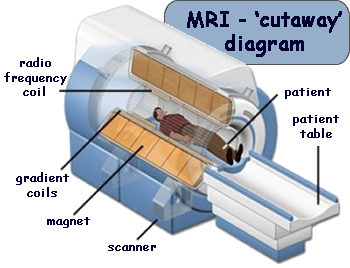Magnetic Resonance Imaging Syllabus Extract - MR Scanner: Basic principles of MR scanner; cross-section of patient scanned using magnetic fields: hydrogen nuclei excited during the scan emit radio frequency (RF) signals as they de-excite: RF signals detected and processed by a computer to produce a visual image. Candidates will not be asked about the magnetic fields used in an MR scanner, or about de-excitation relaxation times.
Magnetic Resonance Imaging (MRI) works by measuring the way that hydrogen atoms absorb and then relax and re-emit electromagnetic energy. Most of the human body is made up of water molecules, which consist of only hydrogen and oxygen atoms and fat, which also contains hydrogen atoms. You are made up of about 60% hydrogen atoms! The nucleus of a hydrogen atom is a proton, and protons are very sensitive to magnetic fields. When the proton spins it generates a manetic field, therefore the nucleus of a hydrogen atom is like a tiny magnet. When your body is in a strong magnetic field all of your hydrogen nuclei line - just like a row of compass needles lining up with a magnetic field.
This variation means that each hydrogen nucleus experiences a slightly different magnetic field strength. This is important for detecting the position of a particular hydrogen nucleus. The frequency of these waves depends on the strength of the magnetic field where each nucleus is and this means that the scanner can work out the location of each nucleus. The MRI scanner sends a pulse of radio signals to certain areas of the body which ‘snaps’ the protons out of position. The pulse gives enough energy to the hydrogen nuclei in that area to change direction. When the pulse of energy ends the nuclei snap back to their original orientation and each nucleus gives off energy in the form of a radio wave. When this happens, each proton transmits a radio signal that provides information about its exact location in the body. On its own, a single proton will not provide much useful information, in the same way that a single pixel on a computer screen is essentially just a coloured dot. However, just as millions of pixels can create images, so the radio signals of millions of protons can be collected together and combined to create a detailed image of the inside of the body and also allow the scanner to work out what type of body tissue the hydrogen nuclei are part of.
|
Follow me...
|


 MRI scanners use powerful magnets. When the powerful magnets that are used in magnetic resonance imaging (MRI) are switched on, all the protons in your body are pulled so that they spin in the same direction, in the same way that a magnet can pull the needle of a compass. The scanner contains several electric coils. This produces variations in the strength of the magnetic field at different points in your body.
MRI scanners use powerful magnets. When the powerful magnets that are used in magnetic resonance imaging (MRI) are switched on, all the protons in your body are pulled so that they spin in the same direction, in the same way that a magnet can pull the needle of a compass. The scanner contains several electric coils. This produces variations in the strength of the magnetic field at different points in your body. 


